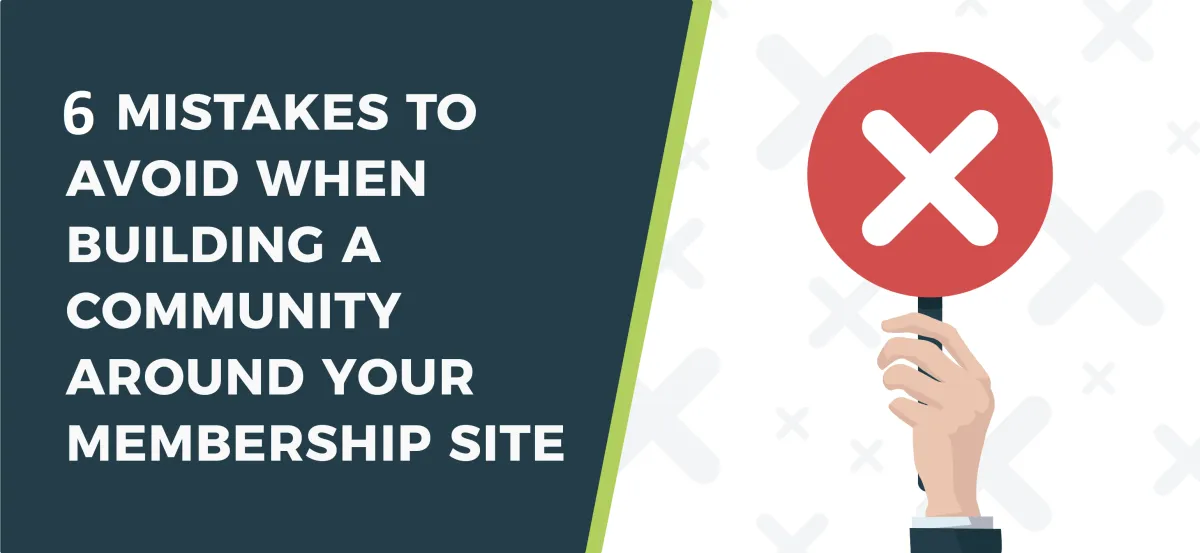Kyvio Blog

6 Mistakes To Avoid When Building A Community Around Your Membership Site
Many online entrepreneurs know they should build a community around their online business.
However, building an online community can be frustrating. You probably don’t have the time and resources to build a community around your brand. Or maybe you don’t even know how to get started.
If any of this sounds like you – don’t feel bad. And also, don’t let it hold you back. A community around your membership site allows you to:
Better understand your customers. This, in turn, allows you to create better courses and products
Give your students a sense of belonging. This, in turn, helps in better course completion rates
Build brand loyalty. Which, in turn, increases your customer’s lifetime value
Increase sales through referrals hence reducing your marketing costs
Without a doubt, building a community around your products has several advantages. The question now is, how do you build a thriving online community to enjoy these benefits?
Today’s post looks at eight mistakes you need to avoid when building your online community. And if you already have a community, read through and see if there’s any mistake you need to correct.
Mistake #1 – Lack of Focus
Thriving online communities have a clear goal.
It could be increasing customer retention. Boosting brand awareness. Or getting feedback from students who bought your online course.
What do you want to achieve from building your online community? Write it down.
Doing so helps you have a clear focus on WHY you’re building the community. Plus, it will help you decide the amount of time and resources you need to build a thriving online community.
Mistake #2 – Ignoring Community Members
Ignoring community members is another rookie mistake many people make.
Examples of how you could ignore your community members include:
Refusing to answer questions from members.
Providing canned responses.
Not welcoming new members.
When building a community or tribe, interaction is critical. There is nothing worse than being ignored. The hunger for connection and community in our lives is real.
To fix this, pay attention to your community members. Start by committing at least 30 minutes every day to connect with your community.
Listen to what they are saying and contribute to the discussions they start. Answer their questions and add value to their lives by posting helpful content.
When they see your dedication to helping them grow, they will reward you with their loyalty. In turn, you will start seeing your community grow with little effort on your part.
Mistake #3 – Posting Irrelevant Content
Posting irrelevant content makes your members lose interest. For example, talking about Cryptocurrency when your members are interested in marketing.
When people lose interest in your online community, they’ll stop engaging and leave.
The key to keeping your members engaged and interested is to post relevant content. Content that reflects the goals of your community and adds value to the lives of your members.
Share a personal story of how you overcame a challenge that your members are likely to come across. Rant about a topic or an issue that you don’t agree with, as you offer alternative solutions.
Mistake #4 – Lacking Community Guidelines
Freedom of speech and thought is a fundamental human right.
This means that every member is entitled to express their thoughts and opinions.
But, if your online community lacks guidelines, things could get out of hand. Spam posts, rude comments, and shameless self-promotion are examples of things gone wrong.
This is where having a community guideline comes into play. Community guidelines are only meant to direct member behavior, and not restrict them.
Do not mistake rules with guidelines though.
Guidelines will help you stay on course and achieve community objectives. As opposed to rules dictating what (or what not) to do.
Rules are inhibiting while guidelines are not.
Not sure where to get started? Use these guidelines as inspiration.
You might need to more strict when you implement guidelines for the first time. As your community grows, members will gradually stick to guidelines with minimal supervision.
Mistake #5 Lacking a Proper Launch Plan
Launching a new community requires a strategic plan if you want to grow it beyond a few hundred members.
Unfortunately, many membership site owners make the mistake of launching without a plan. Instead, they add random people on Facebook with the intention of adding them to their group.
If you want to launch a successful online community, you need to:
Understand your ideal audience: Your online community should focus on serving your ideal customers. These are people who are likely to join your membership site or coaching program.
Create a plan to attract new members: You need to have a system in place to get new members in your community. It could be through a lead magnet for prospects or an add-on bonus to your membership customers
Create discussion topics: We have hinted at this in parts throughout this article. You need to map out what you want to say and at what time. Consistency plays an important role in building an engaged community. A content calendar can also help.
It is vital for you to note that your work is not yet done after you launch. In fact, you immediately take on the role of a community manager the moment you launch your community,
This means you cannot launch and forget your online community. You need to play the role of both facilitator and intermediary.
Meaning you’ll both be starting conversations and resolving conflicts. Mastering these two roles is a surefire way to grow your online community.
Mistake #6 – Focusing on the Wrong Metrics
Here’s another common online community building mistake. Most people focus on the number of community members. What’s the point of having 10,000 community members who are not active?
Metrics are a key component of any online community strategy. While the size of your online community might be impressive, it is more important to identify and monitor key metrics. These help you tie performance back to your business goals.
When measuring the growth and effectiveness of your online community, there are several metrics to focus on. These include:
Number of new members who join the community each month
The number of members who leave? Also known as the churn rate.
Highest and lowest performing content in terms of engagement i.e. likes and comments
The most popular and least popular content topics
The most popular content type (i.e. video, Q&A, text, etc.)
Focus on these key metrics and you are off to a good start with growing your online community. Because now you will know what is working and what isn’t. And this insight will help you create better content that will drive more engagement.
Conclusion
The best communities have one thing in common. They revolve around shared interests, accepted standards, and mutual concern over other members.
As we go through life in work or social situations, we often develop communities or become a part of them. Some are dynamic and exciting, others seem to just go through the motions.
How would your business change if all your customers felt like they belonged?
You can be more intentional and thoughtful as you build your community.
To get started, set community objectives and guidelines. Next, invite the first few members. Then create valuable content to drive engagement. Finally, you’ll need to track key metrics in your community to ensure its performance.
As you do this, you will be helping your members feel connected to the products and services you sell, and to the global society, we all live in.
…and that’s how you end up building a thriving online community.
What tips are you using to build your online community? Share them below.



